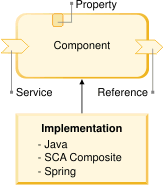Network Deployment (Distributed operating systems), v8.0 > Applications > SCA composites > Learn about SCA composites
SCA components
A Service Component Architecture (SCA) component is a configured instance of an implementation, which is program code that implements one or more business functions such as Java classes. Components provide and consume services. The business functions provide services. Components consume services by referring to services provided by other components. The component configuration sets values for properties that are declared by the implementation and specifies references that point to services provided by other components.
The following graphic shows the parts of a component:
- The chevron pointing towards the component represents a service, or business function, that the component provides to its client.
- The chevron pointing away from the component represents a reference to a service provided by another component.
- The box on the component represents a property value for a property that is declared by the implementation. The component reads the property value from the configuration file when the component is instantiated.

The implementation defines the service in code that is appropriate for the chosen language. For example, a Java component might describe its service using Java interfaces. Supported implementations include Java Pojo, Java EE integration, SCA composites, and Spring 2.5.5 containers.
More than one component can use the same implementation.
SCA composites
SCA in WAS: Overview
Specify bindings in an SCA environment
Use existing Java EE modules and components as SCA implementations
Use Spring 2.5.5 containers in SCA applications
 Concept topic
Concept topic